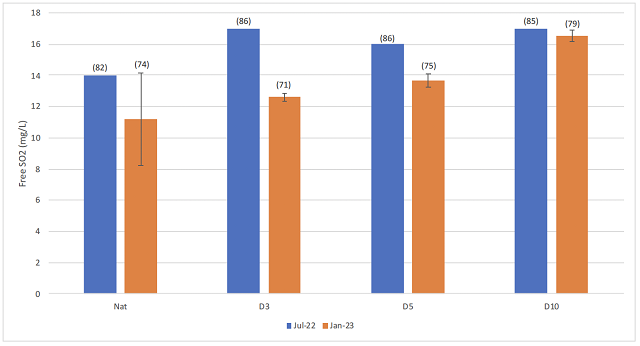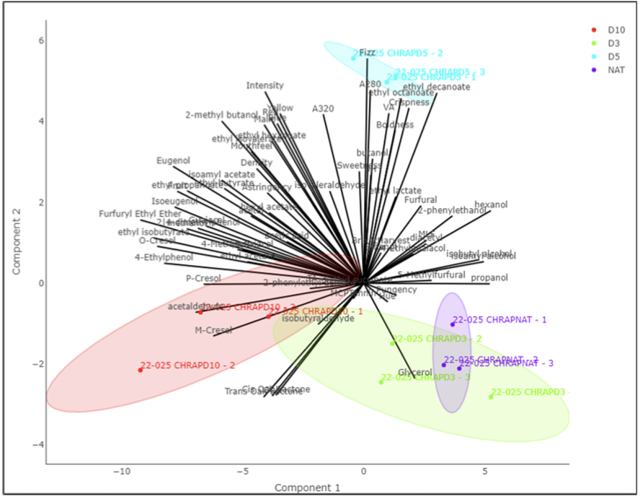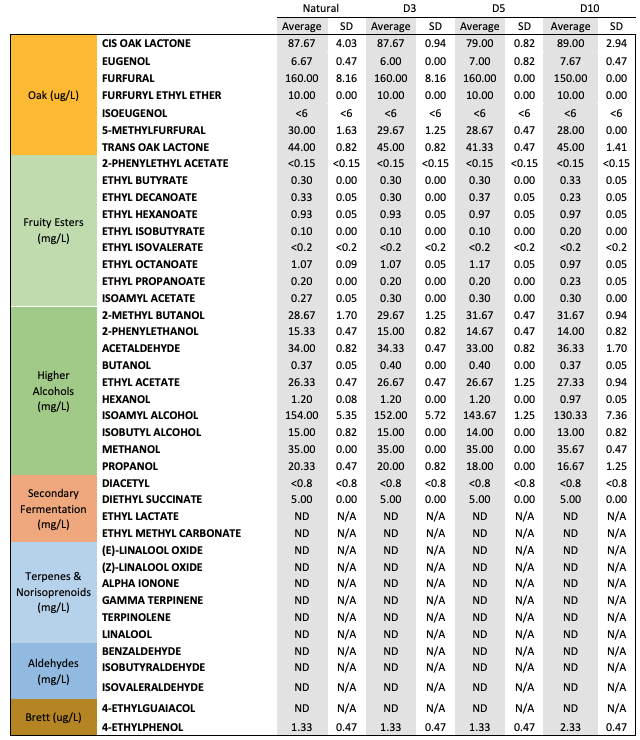Assessing chemical and sensory impacts of different types of corks during bottle aging of reserve Chardonnay (2021)
Theo Smith & Dani Romero
Rappahannock Cellars
Summary
Though natural cork still dominates the market for wine closures, several alternatives are also available to winemakers. In this study, the same wine was bottled with natural cork (Amorim medium) and three different grades of Diam microagglomerated corks (3, 5, and 10), then aged for 18 months before analysis. Wine chemistry after aging was nearly identical among the wines. Chardonnay aged with natural cork had slightly lower free and total SO2 post aging. Dissolved oxygen measures of the wine post aging were more affected by fill height than by cork type, exposing a need for diligent quality control of bottle fill when using manual fillers. Concentrations of odor active compounds were similar for wines aged with natural cork and Diam 3, and differed some for wines aged with Diam 5 and Diam 10. However, there were no significant differences in scores for Chardonnay varietal character, fruit intensity, reduction or oxidation when evaluated by winemakers in a sensory session.
Introduction
Natural cork has been the primary means used to seal wine bottles for hundreds of years.1 However, in the mid 20th century, issues with manufacturing processes led to increased risk of cork taint, primarily through the formation of TCA.1 Though the threat of TCA is lessening due to improvements in manufacturing practices,1 the issue has allowed several alternative closures onto the market.
In a 2021 Wine Business Monthly Survey, 70% of winemakers indicated they use natural corks in at least some of their wines, with 54% indicating they used natural cork in all their wines. These percentages were much higher than any other closure type. However, when asked if they had stopped using one type of closure for another in the past year, 37% said they had, and for most, this included moving away from natural cork.2
In the same WBM survey, screwcaps enjoyed the largest rise in popularity in the past year, with an increasing number of winemakers reporting they use screwcaps in at least one of their wines (from 30-40% in past years to 52%). Screwcaps received higher satisfaction scores from winemakers than other closures (4.1/5 compared to 3.9-4.0/5 for natural cork), however, they require specialized bottling equipment for application, and sometimes suffer from lack of consumer acceptance.
Agglomerate corks entered the WBM survey for the first time in 2021, with just under 30% of winemakers reporting usage. Microagglomerated corks offer a lower cost option for TCA free closures (Table 1) that don’t require specialized equipment and are potentially more accepted by consumers than synthetic alternatives.1 Agglomerated corks are made up of small particles of cork that have been prepared like natural cork (drying, then boiling in water), then crushed to form small particles. The particles are then processed with supercritical CO2 (a state intermediate between liquid in and gas) to extract any compounds that cause sensory deviations (TCA and others). Purified grains are then joined with microspheres and binders and molded and baked to produce corks with consistent OTR and elasticity.3 Environmental concerns about microplastics have led to many companies replacing microspheres with non-plastic alternatives.
Due to their relatively recent introduction, less is known about how wines age in bottles sealed with microagglomerated corks vs. other closure types. Most studies have been done comparing synthetic corks, screwcaps and natural cork.4,5 Though micro-agglomerated corks likely perform similarly to natural cork in many ways, some important differences should be considered. Microagllomerated corks are less expensive (Table 1) than natural corks, especially corks of medium to high quality. Diam (the manufacturer of microagglomereated cork) claims microagglomerated corks are more consistent, given that their manufacturing process allows more control than the natural variations found growing on trees.3Microagglomerated corks also have generally lower initial oxygen release into the wine (Table 1). A typical natural cork contains 3.5 mL of oxygen in the tiny cells that make up the cork. When compressed for bottling, 6-9 atmospheres of pressure are exerted on these cells, which is then equilibrated over the next 6-9 months, resulting in oxygen ingress into the headspace. Differences in cellular structure between corks leads to differences in initial oxygen ingress.6 Microagglomerated corks contain fewer cells overall, and therefore have less initial oxygen ingress.3,7
The purpose of this study was to compare the use of natural cork (Amorim medium) with three different grades of Diam microagglomerated corks (3, 5, and 10) for their effect on wine quality, ageabilty, and cost in a reserve Chardonnay.
Table 1: Price, oxygen initial release and oxygen transmission rate for four different types of corks*

*Diam rates reported by manufacturer. Amorim rates reported by Wine and Beer Supply
Methods
Diam corks were prepared for the trial and donated by Hauser packaging. Wine was prepared for bottling according to the SOP of the winery. During the bottling run, after a full pallet of wine had been bottled using the standard cork for the winery, corks were replaced with the first experimental cork type. While the line was still running, corks were replaced sequentially until all experimental cork types had been used, then the standard cork was re-introduced. Two cases of wine were held aside for each type.
The impact of closure type on wine quality includes the initial release of oxygen from the cork cells, the oxygen Initial release (OIR). OIR is the dominant influence of cork type in the first 6-12 months after bottling.3,8For this reason, wines were analyzed in July 2022, one year post bottling. Three bottles of each treatment were sent to Tastry and one bottle was sent to ETS in July 2022. Tastry uses analytical chemistry and automated feature engineering to describe the flavor matrix of wine. AI systems integrate concentrations, thresholds and interactions of hundreds of compounds found in the wine matrix to predict the overall sensory characteristics of the wine as well as how well that wine will be received by consumers. For this experiment, only concentrations themselves were used for analysis.
Free SO2 was measured using a Sentia wine analyzer when bottles were opened for sensory analysis (Jan 25, 2023). A second bottle of each treatment was sent to Imbibe solutions the following day to determine free and total SO2. Dissolved oxygen was measured for three bottles of each treatment using a handheld DO meter inserted into the bottle immediately after opening, before wine was poured for sensory analysis.
Sensory analysis was completed by a panel of 19 wine producers. Wines were presented blind in randomly numbered glasses. Tasters were presented with four different wines, each aged in bottles sealed with a different type of cork. Tasters were then asked to score each wine on a scale of 0 to 10 for Chardonnay varietal character, fruit intensity, reduction and oxidation. Tasters were also asked to estimate how long each wine had spent in the bottle. These values were converted to years. Lastly, tasters were given open-ended questions to describe the wines. Descriptive scores and age estimates were analyzed using repeated measures ANOVA. If significant differences were found among scores, Tukey’s test was used to determine which categories were significantly different from one another.
The oxygen transmission rate of the closure becomes more important 2-30 years into the life of the bottled wine. These results represent effects a full year post bottling. Wines will be analyzed again after 3 years in bottle to allow time for OTR effects to work.
Results
Wine chemistry after one year of aging in bottle was very similar among the treatments (Table 2). The wine aged with Diam 10 had slightly lower A420 nm in July 2022, indicating potentially less oxidation in this wine.
Table 2: Wine Chemistry of Reserve Chardonnay bottled with four different types of corks (August 2022, ETS Labs)

Both in July 2022 and again in January 2023, the wine bottled with natural cork had the lowest level of free SO2 among the treatments (Figure 1), which is consistent with the higher OIR value expected in natural vs. agglomerated cork (Table 1). Less oxygen ingress (through initial release and transmission over time) in the agglomerated cork leads to fewer binding targets for SO2, allowing more SO2 to remain in the free form. Regardless of closure, each of the wines still had sufficient free SO2 to provide antioxidant protection (which is thought to be 11-12 ppm).
Figure 1: Free SO2 measured in July of 2022 and January of 2023. In January, Free SO2 was measured in duplicate for Diam corks and five times for natural corks. Endcap values report Total SO2.

There was a wide range of dissolved oxygen values among bottles, even within the same treatment (Figure 2). Bottles with the highest DO values also had noticeably lower fill volumes, indicating the difference in DO was more likely due to the introduction of oxygen in the headspace during bottling rather than oxygen ingress through the closure. The AWRI oxygen management audits have shown that 60% of total package oxygen comes from the headspace at bottling.9 If using a manual fill line, checking fill height regularly may be a good strategy for reducing total package oxygen.
Figure 2: Dissolved oxygen in January 2023 (WRE in-house data). Numbers in parenthesis in the legend indicate how many samples were included

A comparison of raw concentrations of odor active compounds can be found in Appendix 1. For each, three bottles were tested and values were averaged. A list of descriptors and threshold values for these odor active compounds can be found in Appendix 2. Odor active values have been taken from published sources including AWRI, UC Davis, and others.
Some odor active compounds do appear to be significantly different among cork types (Table 3), however in some cases these molecules are below the odor threshold and therefore differences may not be perceptible. For example, wines bottled with natural and Diam 3 corks have lower levels of eugenol than those bottled with Diam 5 and Diam 10 corks. However, the threshold for detection of eugenol in wine is 15 ug/L and each of these values is below 10 ug/L.
In other cases, such as seen in ethyl decanoate, compounds are present at levels above the sensory threshold (0.2 mg/L is the threshold for this compound), however values for detection of sensory differences are not known. Though 0.2 mg/L can be detected, is a difference of 0.23 mg/L (Diam 10) perceptibly different from 0.33 mg/L (natural cork)? In addition, perception of sensory compounds is very influenced by context, as is evidenced by the number of descriptors often offered for the sample compound.
Table 3: Odor active compounds for reserve Chardonnay bottled with four different cork types. Only compounds with significant differences between types are shown (Tastry, July 2022).

Figure 3: 69 Component, Partial Least Squares-Discriminant Analysis “PLS-DA” for three replicates of Reserve Chardonnay bottled with four types of corks (Tastry, July 2022)

Several compounds (ethyl octanoate, 2-methyl butanol, acetaldehyde, isoamyl alcohol, and isobutyl alcohol) were found in similar concentrations in wines sealed with natural cork and Diam 3 but different concentrations in wines sealed with Diam 5 or Diam 10 closures. This relationship was also apparent in a 69-component, partial least squares-discriminant analysis performed by the Tastry algorithm (Figure 3). However, when scored by winemakers, there were no perceptible differences in sensory characteristics among the wines for any of the descriptors scored (Table 4). Additionally, scores for estimated time in the bottle were very similar among all cork types (Table 5).
Table 4: Descriptive scores from WRE Sensory Session (January 2023)

Table 5: Estimate Time (Years) Spent in Bottle of Chardonnay

References
(1) Taber, G. M. To Cork or Not To Cork, 1st ed.; Scribner: New York, 2009.
(2) Lasky, M. TCA Guaranteed Natural Cork Gains Winemakers Trust, but Screw Cap Adoption Soars as Well. Wine Business Monthly. 2021, pp 50–56.
(3) A cork closure at the service of your wine. Diam. https://www.diam-closures.com.
(4) Díaz-Maroto, M. C.; López Viñas, M.; Marchante, L.; Alañón, M. E.; Díaz-Maroto, I. J.; Pérez-Coello, M. S. Evaluation of the Storage Conditions and Type of Cork Stopper on the Quality of Bottled White Wines. Molecules 2021, 26 (1).
(5) Waterhouse, A. L. A chemist explains why corks matter when storing wine. Wine Folly. https://winefolly.com/deep-dive/chemist-explains-corks-matter-storing-wine/.
(6) Oliveira, V.; Lopes, P.; Cabral, M.; Pereira, H. Kinetics of Oxygen Ingress into Wine Bottles Closed with Natural Cork Stoppers of Different Qualities. Am. J. Enol. Vitic. 2013, 64 (3), 395–399.
(7) Corks and Closures and Caps. Wine & Beer Supply. https://www.wineandbeersupply.com/collections/corks-and-closures.
(8) Wong, D. P. Taking Control of Total Package Oxygen. Wine Business Monthly 2020, No. March 2020.
(9) Oxygen pick-up during packaging - understanding total package oxygen. AWRI. https://www.awri.com.au/industry_support/winemaking_resources/storage-and-packaging/packaging-operations/oxygen-pick-up-during-packaging-understanding-total-package-oxygen/.
Appendix 1: Comparison of odor active compounds for Reserve Chardonnay bottled with four different cork types (Tastry, July 2022)

Appendix 2: Sensory impacts of odor active molecules in wine (Tastry)

